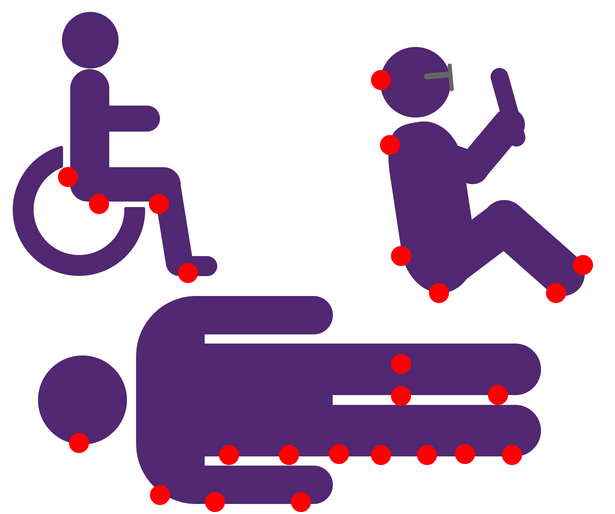Fill our form to download your free research report, written by Dr Mark Hawker.
Pressure Ulcers: What Are They And How Can You Prevent Them
What Is A Pressure Ulcer?
Simply put, a pressure ulcer is localised damage that occurs to the skin and/or the underlying tissue caused by unrelieved pressure.
Ulcers can range from mild damage (typical you’d notice it as a red patch with breaks in the skin) to deeper damage (dark red or purple with black patches that can turn into much bigger wounds).
What Cause’s Pressure Ulcers?
There are two main causes for a pressure ulcer to develop. Either Pressure, caused by a concentration of body weight on one particular area over a period of time or something called Shearing. Shearing is caused by the skin being pulled in different/wrong/unusual directions. Actions that can cause this include (but aren’t limited to)…
- Sliding or slumping down in a chair or bed
- Sitting in a chair that’s the wrong size for you (too wide, narrow, small, high or low)
- Sliding down the bed and then pushing yourself back up
- Rubbing and or massaging certain areas
- Badly fitting clothes or shoes
Am I At Risk Of Pressure Ulcers?
Many people can be at risk of developing a pressure ulcer, especially if any of the below apply…
- Being unable to move around very well
- Sitting in or using a wheelchair for long periods of time
- Poor blood circulation
- Any kind of spinal injury that may have resulted in a loss of sensation
- Diabetes, certain neurological diseases, strokes, heart disease or lung disease
- Smoking
- Incontinence
- Excessive perspiration or sweating
- Previous injuries or wounds to areas pressure ulcers are commonly found in (see below)
- Having lots of skin folds
- Bad diet or poor fluid intake
- Being under or overweight
- Having dry or otherwise poor skin condition.
Most Likely Locations Of Pressure Ulcers

Early Signs Of A Pressure Ulcer
Early identification/diagnosis of a pressure ulcer is vital in treating and stop them from spreading. You may notice some of these as an early sign of a pressure ulcer…
- Changes in the colour of your skin (be on the look out for red patches on light skin or bluish/purplish patches on darker skin) that don’t go away
- Changes to the ‘feel’ of your skin (soreness, pain. numbness etc…)
- Increased pain on any of the common locations shown above
- Warm/hot sensations in any of the locations shown above
- Blisters/blistering on any pressure points, especially any of the ones shown above
- Swelling on/over any sore areas of skin.
Pressure Relieving Equipment…
Whilst pressure relieving equipment is vital in the prevention/treatment of pressure ulcers it should be noted that they’re only part of a solution. It’s important to discuss all options with your health care professional to discuss what’s best for you.
Mangar health offer the Mangar Ekamove which is an automated, sensor controlled patient positioning system which can be programmed to meet the individual needs of the patient. It’s designed to gently and quietly turn patients up to 30°, without the intervention of a healthcare professional thus helping the prevention and treatment of pressure ulcers.
You can learn more about Mangar’s Ekamove here:
How Can I Avoid A Pressure Ulcer?
- Tell your healthcare professional as soon as you notice any sore or painful patches of skin
- If possible, gently change your position as often as you can or if not ask for someone’s help to do it for you
- As we mentioned earlier, try to avoid repeated friction or shearing.
- Try to keep your heels elevated to minimise pressure damage.
- Make sure either yourself or someone else is checking your skin daily for signs of damage. (Top tip: If you’re on your own using a mirror should let you see most areas not normally visible to yourself)
- After a bath or shower don’t ruby our skin dry, gently pat it instead.
- Try to protect your skin from excessive moisture and/or dryness
- Stick to a well-balanced diet and make sure you keep yourself hydrated
- Keep the number of layers between your skin and your pressure reliving mattress/cushion to a minimum
- If you find yourself in a bed or chair for a long period try to avoid crumbs or creases in the material that could rub on your skin
- If possible, give up smoking
Who Should I Contact If I think I’ve A Pressure Ulcer?
If you’re at all worried, think you may be/have developed a pressure ulcer or may be at risk of developing one due to your circumstances and would like to take preventative measures then your first port of call should be to contact your GP or healthcare professional as soon as possible.
The quicker a pressure ulcer is identified, the easier it is to prevent or treat.
Where Can I learn More About Pressure Ulcers?
If you’d still like to learn more then we have more information on the Treatment Of Pressure Ulcers Here…
Reference: Kent Community Health NHS Foundation Trust
- May 14, 2018









